The Motorola Moto G4 and G4 Plus Review
by Brandon Chester on August 15, 2016 8:00 AM EST- Posted in
- Smartphones
- Lenovo
- Motorola
- Moto G
- Moto G4
System Performance
The Moto G has had an interesting history regarding performance improvements. The original model launched with Qualcomm's Snapdragon 400 SoC, which was very good for its time with four Cortex A7 cores. In a strange move, the second generation Moto G launched with the same SoC, and was pretty much just the original Moto G with the screen size increased from 4.5 to 5 inches. A few months later, the second generation Moto E launched with Qualcomm's Snapdragon 410 SoC, which outperformed the existing Moto G on all fronts, leaving it in an awkward position. The third generation Moto G also moved to Snapdragon 410 later that year, and for the fourth iteration we now see the use of Qualcomm's Snapdragon 617 SoC.
Because the internal hardware of our Moto G4 and G4 Plus units is only differentiated by the amount of RAM included, I have only run our standard benchmarks on the G4 Plus. Given that they share the Snapdragon 617 SoC, the CPU and GPU performance of the phones should be identical. I would have liked to have the Moto G4 Play in the comparisons, but it shares an SoC with the 2015 model of the Moto G and so that can be used as a point of comparison instead.
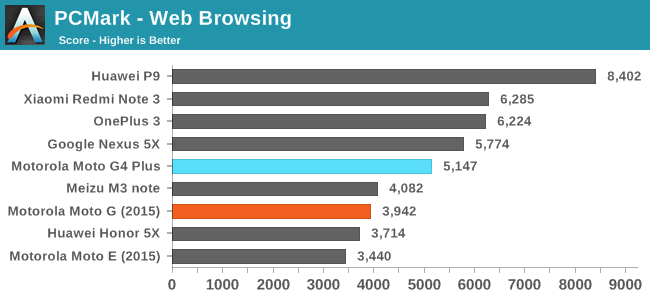
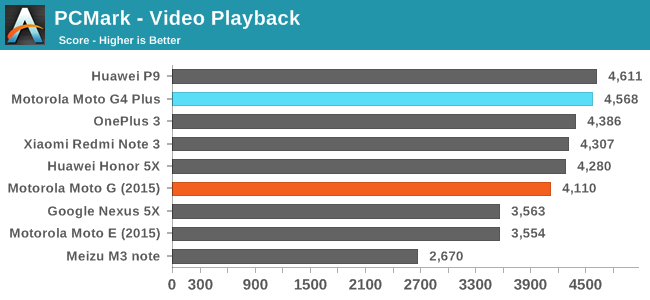
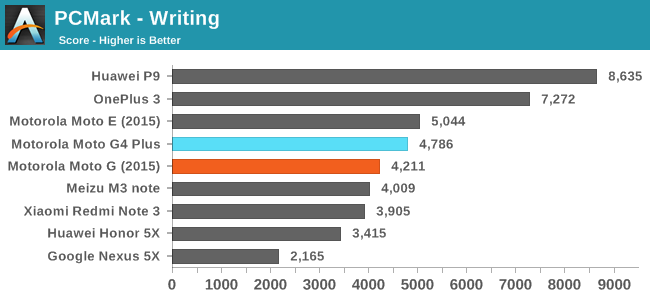
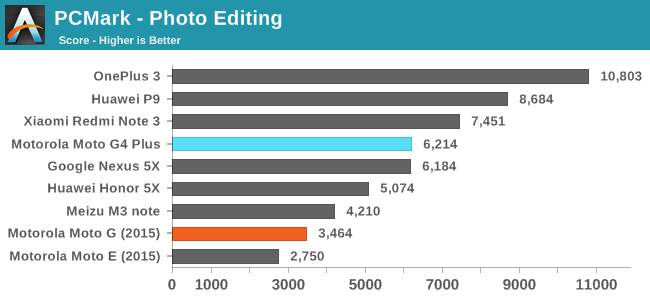
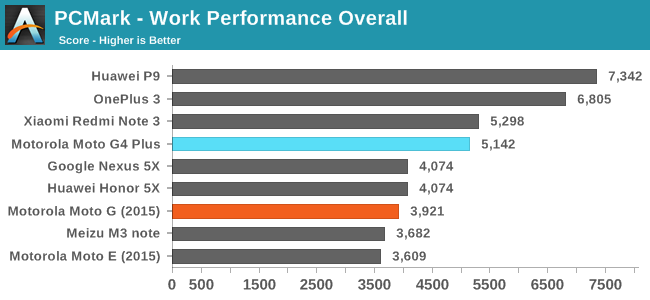
The Moto G4 pulls ahead of the 2015 model in PCMark, with the most significant gain being in the Photo Editing test. This test makes use of the GPU for processing, and the greater GPU performance that Adreno 405 provides compared to Adreno 306 is to thank for the nearly doubled photo score. As for the other tests, there are improvements, but apart from the web test the differences between the new Moto G and the old one are fairly small.
Moto G4 and G4 Plus Hot App Launch Times
Moto G4 and G4 Plus Cold App Launch Times
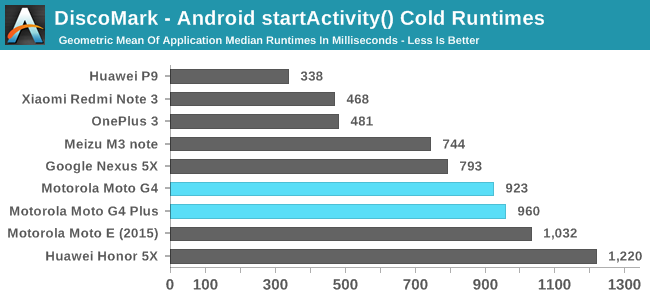
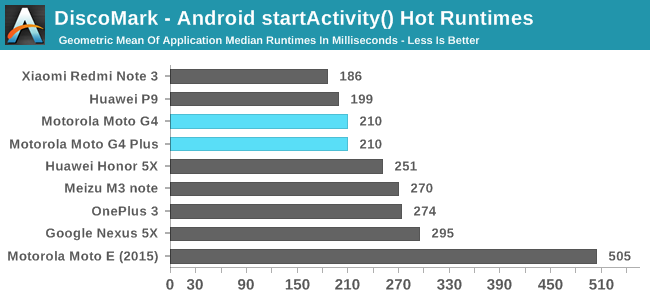
DiscoMark is one of the best benchmarks we have to describe the speed of a device. Delays in switching between apps can be painful from a UX perspective, and DiscoMark allows us to evaluate how quickly a device can resume an application that is resident in memory, as well as how quickly it can start one up from scratch.
One would think that the 64GB model of the Moto G4 Plus having 4GB of RAM would lead to improvements in DiscoMark, but in both cold and hot app launches the Moto G4 and G4 Plus perform similarly. To be honest, in this case the issue comes down to the size of the test set, as it is obvious when using many apps that the Moto G4 with 2GB of RAM has to reload them more frequently than the G4 Plus with 4GB of RAM. The only thing to note is that the G4 Plus seems to be more consistent with how long it takes to cold launch an app, which may be due to the additional memory being used for data caching.
The cold start times demonstrate the performance gap between mid-range and high-end devices. The average median time to launch an app on the Moto G4 and G4 Plus is nearly one second, which feels like an eternity when you just want to open something like a weather app to quickly check if it's going to rain. When you go from a $200 phone to a $400 one, this time is nearly halved. It may be that inexpensive phones can do a good job of scrolling a list and swiping between tabs smoothly, but high-end devices still have a clear advantage in circumstances such as these where the speed of launching an app is primarily a function of your SoC and DVFS settings.
The Xiaomi Redmi Note 3 is an exception to the rule. Priced around $150 depending on your storage configuration, the use of Snapdragon 650 with its Cortex A72 cores gives it a huge lead over mid-range phones that only have Cortex A53 cores. Being able to launch apps in half the time is a big advantage, and I think it's safe to say that the $50 extra for the Moto G4 Plus would have been better spent on improving the SoC instead of adding an IR rangefinder to the camera and a poorly implemented fingerprint scanner.
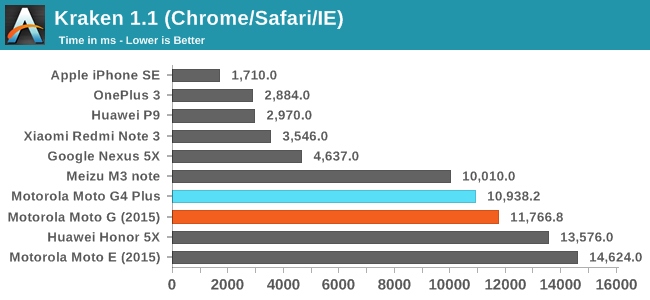
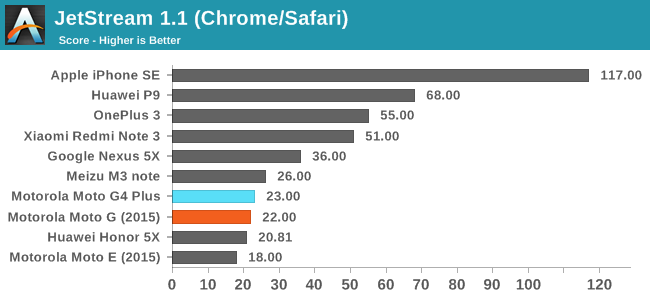
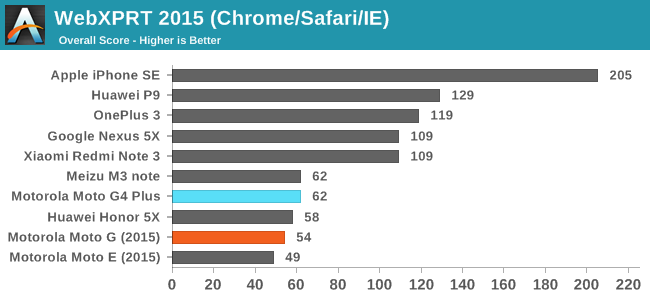
The general lack of improvement in web performance isn't unexpected. I re-tested the 2015 Moto G on Marshmallow with the latest version of Google Chrome and saw no improvements. The Moto G4 and G4 Plus still run only on Cortex A53 cores, and the performance cluster is at 1.5GHz which is only 100MHz faster than the Snapdragon 410 in the 2015 Moto G. JavaScript performance is really bound by the performance of a single core, so there was never going to be much improvement here.
Real World and UI Performance
I reviewed the 2015 models of the Moto E and Moto G. I recommended both of them as the best Android devices in their class, because they made smart decisions regarding the balance of specifications, and they made the most of what you could do in a smartphone at their price points. At this point I've come to expect that even inexpensive Android devices can handle the basics of the Android interface without dropping too many frames. Motorola was a pioneer in making inexpensive phones that ran a lightly modified version of Android and did so with great UI performance. Obviously you didn't get the speedy app launch times of flagship smartphones, but once you were in your apps they all ran fairly smoothly.
The reason I bring this up, is because I can't say any of these things about the Moto G4 and G4 Plus. To address my first point, it's clear from the Moto G's specs that under Lenovo there's now a much greater focus on appealing to the Chinese market, and in many ways that really doesn't lead to a better smartphone. I already commented on how moving to 5.5" compromises usability compared to the previous models of the Moto G, but the internal specs of the phone tell a story of their own. The Moto G4 replaces the Snapdragon 410 SoC from the 2015 Moto G with Snapdragon 617.
Choosing an eight core Cortex A53 SoC to appeal to the Chinese market instead of a six core Snapdragon 650 was not a good decision for the user experience. There is basically no tangible CPU performance benefit that Qualcomm's eight core Cortex A53 SoCs provide over their quad cores, apart from the obvious speed improvements that come with higher clocks. Snapdragon 650 may not have been in the cards for the $200 Moto G4, but in the $250 model of the Moto G4 Plus the use of an SoC with a much faster CPU would have been a wiser investment than the fingerprint scanner and the laser autofocus for the camera. Playing the specs on paper game was never what the Moto G was about, it was about providing a well-balanced smartphone at a great price, and I don't see that philosophy in the new Lenovo-owned Motorola.
Any bar above the green line is a frame that took too long to render, causing sub-60fps rendering
Sticking with Cortex A53 throws away the chance to increase the phone's speed by cutting down load times, but Motorola has shown in the past that they can keep animations smooth even with relatively little processing power. For whatever reason, the Moto G4 often can't accomplish this either. There's clearly more stuttering throughout the UI than on the 2015 Moto G, with many ListViews and even RecyclerViews stuttering constantly when scrolling, while the 2015 Moto G remains smooth in the same situations. The level of input lag is also really bothersome, and scrolling seems to not respond correctly at times, with forceful swipes only shifting a list by a few rows. While the Moto G4 is pushing a higher resolution, it also has significantly more GPU processing power and I doubt that the performance issues are the result of inadequate hardware. More likely is that we're dealing with less than optimal firmware on the Moto G4, and later in the review you'll see other info to support this idea.
In the end, I don't feel that the Moto G's speed or fluidity is at the level it should be for a mid-range phone launching in the second half of 2016. When Xiaomi is bringing Snapdragon 650 to $150 smartphones, the performance of quad and octa-core Cortex A53 SoCs really only remains acceptable in low-end smartphones priced at $100 or less. On top of the relatively slow performance for an H2 2016 mid-range smartphone is the stuttering and input lag in the UI that makes the Moto G4's fluidity and responsiveness worse than its predecessor. The performance of the first Moto G to launch under Lenovo's ownership is unimpressive to say the least, and I think Lenovo and Motorola need to take a look at what made the previous Moto G phones great in order to understand why they've gone so far off course.


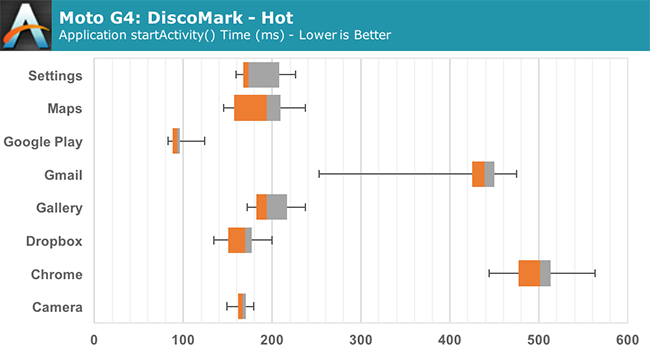
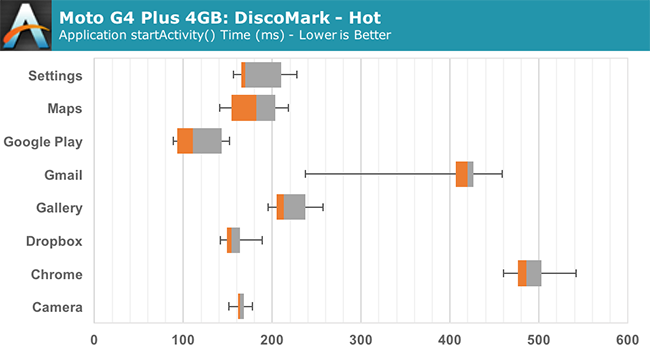
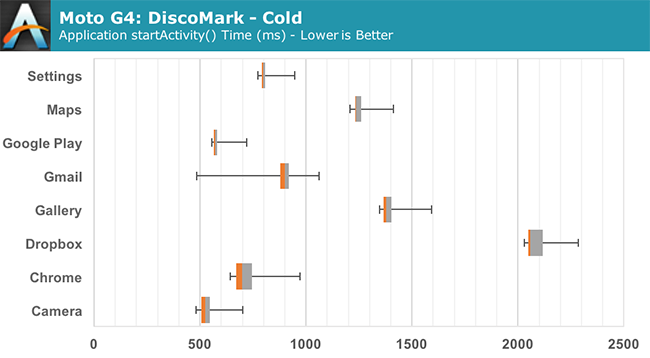
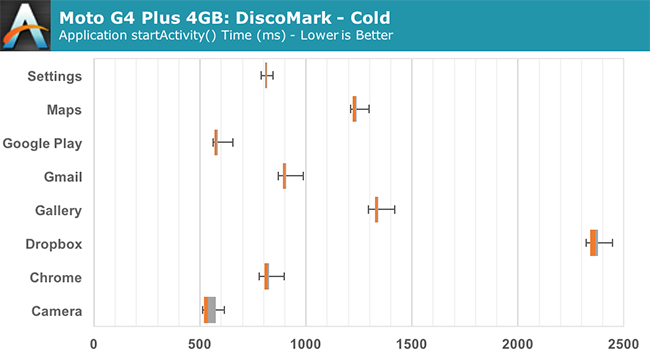
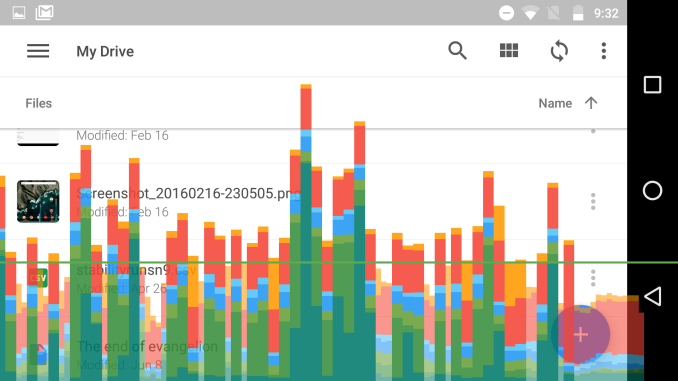








94 Comments
View All Comments
markiz - Tuesday, August 16, 2016 - link
Like, 80% of the time the phone is on it's back on the table.When I'm at work, and want to check out an IM or weather, or whatever, I don't pick it up, almost never. Faster (and stealthier) to keep it laying.
jabber - Monday, August 15, 2016 - link
Don't get why you would brand your phone the same as another G4. Most odd.zeeBomb - Monday, August 15, 2016 - link
Hey Brandon, do you think with the Nexus 5X, the HDR+ mode should be the go to mode like an auto mode for camera shots?grayson_carr - Monday, August 15, 2016 - link
When the 5X and 6P first came out, Anandtech always tested them with HDR+ enabled, but after 6 months or so, they decided that Google should stop being lazy and improve their image processing when not using HDR+ mode, so they started testing without HDR+ mode enabled.Brandon Chester - Monday, August 15, 2016 - link
Yes you should use HDR+. I have since stopped using it in reviews because it's not acceptable to take 1-2 seconds per shot for processing to get a usable image, and because HDR+ introduces exposure problems of its own. The quality of Google's normal processing is several years behind the best smartphones, and they need to do better.zeeBomb - Monday, August 15, 2016 - link
Wow :o from good to problematic in a short span if time...good to know. Thanks!Omega215D - Monday, August 15, 2016 - link
I'd advise against Motorola phones now that they are under Lenovo since the camera module on my Moto Z Force has suddenly worsened after a glitch when switching from regular Photo mode to Professional in which parts of the frame displayed exhibited what looked like broken LCD with top half in green and heavy artifacting and the bottom in red with heavy artifacting. Switching modes got it out of that but now photos taken in lower light settings are worse than my HTC One M8 which wasn't the case befor and Moto is slow to respond to my issue.Badelhas - Friday, August 19, 2016 - link
Yeah, since the "We will not update the Moto E 2015" controversy (8 month old popular smartphone) , Motorola lost all of the confidence I had in the company and I won't be suggesting one of their devices to anyone, ever.Hrel - Monday, August 15, 2016 - link
Sadly they made it bigger, 5.5" is too big. Why wouldn't they just leave it at 5" and do the 1080p screen?Just sad.
greyhulk - Monday, August 15, 2016 - link
Too big for you, maybe. That's the minimum size for me now.